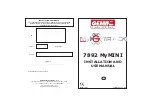
UBX-G7020 - Hardware Integration Manual
Design-in
GPS.G7-HW-10003
Objective Specification
Page 23 of 74
2.2.7.2
3-pin antenna supervisor
The 3-pin antenna supervisor comprises pin PIO14 for ANT_DET (active antenna detection), PIO15 for
ANT_SHORT_N (short detection) and PIO16 for ANT_OFF (antenna on/off control). This function must be enabled
by Low Level Configuration.
PIO #
Function
I/O
Description
Remarks
PIO14 ANT_DET
I
(pull-up)
Antenna detected
“high” = Antenna detected
“low” = Antenna not detected
Polarity can be changed by Low Level
Configuration if the external circuitry requires
other polarity, see section 2.10.2
PIO15 ANT_SHORT_N I
(pull-up)
Antenna not shorted
“high” = antenna has no short
“low” = antenna has a short
Polarity can be changed by Low Level
Configuration if the external circuitry requires
other polarity, see section 2.10.2
PIO16 ANT_OFF
O
Control signal to turn on and off the antenna supply
“high” = turn off antenna supply
“low” = short to GND
Polarity can be changed by Low Level
Configuration if the external circuitry requires
other polarity, see section 2.10.2
Table 7: 3-pin Antenna supervisor pins
The external circuitry as shown in Figure 8 provides detection of an active antenna connection status. i.e. if it is
present the DC supply current exceeds a preset threshold defined by R4, R5, and R6 It will shut down the
antenna via transistor T1 if a short circuit has been detected via U7 or if it
’
s not required (e.g. in Power Save
Mode).
The status of the active antenna can be checked by UBX-MON-HW message. See the
u-blox 7 Receiver
Description including Protocol Specification
Figure 8: 3-pin Antenna Supervisor
If the antenna supply voltage V_ANT exceeds VDD_IO, the open drain buffers U4, U7 and U8 (e.g.
Fairchild NC7WZ07) are needed to shift the voltage levels. R3 is required as a passive pull-up to control T1
because U4 has an open drain output. R4 serves as a current limiter in the event of a short circuit.
Confidential
















































